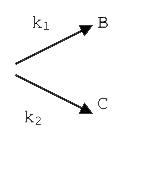For first order parallel reactionK1 and K2 are 4 and 2min−1 respectively at 300K. If the activation energies for the formation of B and C are respectively 30,000 and 38,314 Joul/mol respectively. The temperature at which B and C will be obtained in equimolar ratio is 47x. Hence x is _____________Solution in Telugu
The correct Answer is:8
AK−−→B
AK−−→C
yB=K1K1+K2=yC=K2(K1+K2)…….1 , K1=Ae−ε/RT…….2
K2=Ae−εa2/RT…….3, K=Ae−εe/RT………………..4 If T1=300K,T2=376K
Topper's Solved these Questions
- CHEMICAL KINETICSBook:AAKASH SERIESChapter:CHEMICAL KINETICSExercise:Examples
Explore 32 Videos
- CHEMICAL KINETICSBook:AAKASH SERIESChapter:CHEMICAL KINETICSExercise:Subjective Exercise -1 (Long answer questions)
Explore 1 Video
- CHEMICAL KINETICSBook:AAKASH SERIESChapter:CHEMICAL KINETICSExercise:PRACTICE SHEET-5 (MATCH THE FOLLOWING QUESTIONS)
Explore 2 Videos
- CHEMICAL KINETCSBook:AAKASH SERIESChapter:CHEMICAL KINETCSExercise:EXERCISE - 3.2
Explore 45 Videos
- CHEMICAL THERMODYNAMICSBook:AAKASH SERIESChapter:CHEMICAL THERMODYNAMICSExercise:Additional Practice Exercise
Explore 54 Videos
Similar Questions
Formation of water from its elements is spontaneous, but is slow. Comment .
View SolutionThe rate of a chemical reaction
View Solution
View SolutionDiscuss on the kinetic spontaneity of a chemical reaction. Is a slow reaction spontaneous? Why?
View SolutionWhich among the following is not an exact differential?
View SolutionFor the reaction A+B hArr 3. C at 25^(@)C , a 3 L vessel contains 1, 2, and 4 moles of A, B and C respectively. Predict the direction of reaction if: a. K_(c) for the reaction is 10 . b. K_(c) for the reaction is 15 . c. K_(c) for the reaction is 10.66
View SolutionA reaction takes place in various steps. The rate constatn for first, second, third and fifth steps are k_(1),k_(2),k_(3) and k_(5) respectively The overall rate constant is given by k=(k_(2))/(k_(3))(k_(1)/(k_(5)))^(1//2) If activation energy are 40, 60, 50, and 10 kJ/mol respectively, the overall energy of activation (kJ/mol) is :
View SolutionFor first order parallel reactions k_(1) and k_(2) are 4and 2min(-1) respectively at 300 K. If the activation energies for the formation of B and C are respectively 30,00 and 38,314 joule/ mol respectively, the temperature at which B and C will be obtained in equimolar ratio is :
View Solutionसमान संवेग वाली दो वस्तुओं के द्रव्यमान क्रमशः m तथा 2m हैं | इनकी गतिज ऊर्जाओं K1 व K2 का क्रमशः अनुपात होगा :
View SolutionThe rate constants of two first order reactions at a specific temperature are k1andk2 , respectively . If k1>k2 , then which reaction has a longer half-life ?
View SolutionAt a given temperature, the rates of two first order reactions, A rarrB and Crarr D " are " k_(1) and k_(2) respectively. If k_(1)ltk_(2) , then which of these reactions will have a shorter half-life?
View SolutionThe rate constant and half-life of a first order reaction at temperature T1 are k1min−1andx1min , respectively and those at temperature T2 are k2min−1andx2 min , respectively. If T2>T1 , which is greater , x1 or, x2 ?
View SolutionA substance undergoes first order decomposition. The decomposition follows two parallel first order reactions as :
k1=1.26×10−4s−1,k2=3.8×10−5s−1
The percentage distribution of B and C are :

View SolutionThe substance undergoes first order decomposition. The decomposition follows two parallel first order reactions as : K_(1)=1.26xx10^(-4) sec^(-1) and K_(2) =3.8xx10^(-5) sec^(-1) The percentage distribution of B and C
View SolutionA reaction takes place in various steps. The rate constatn for first, second, third and fifth steps are k_(1),k_(2),k_(3) and k_(5) respectively The overall rate constant is given by k=(k_(2))/(k_(3))(k_(1)/(k_(5)))^(1//2) If activation energy are 40, 60, 50, and 10 kJ/mol respectively, the overall energy of activation (kJ/mol) is :
View Solution